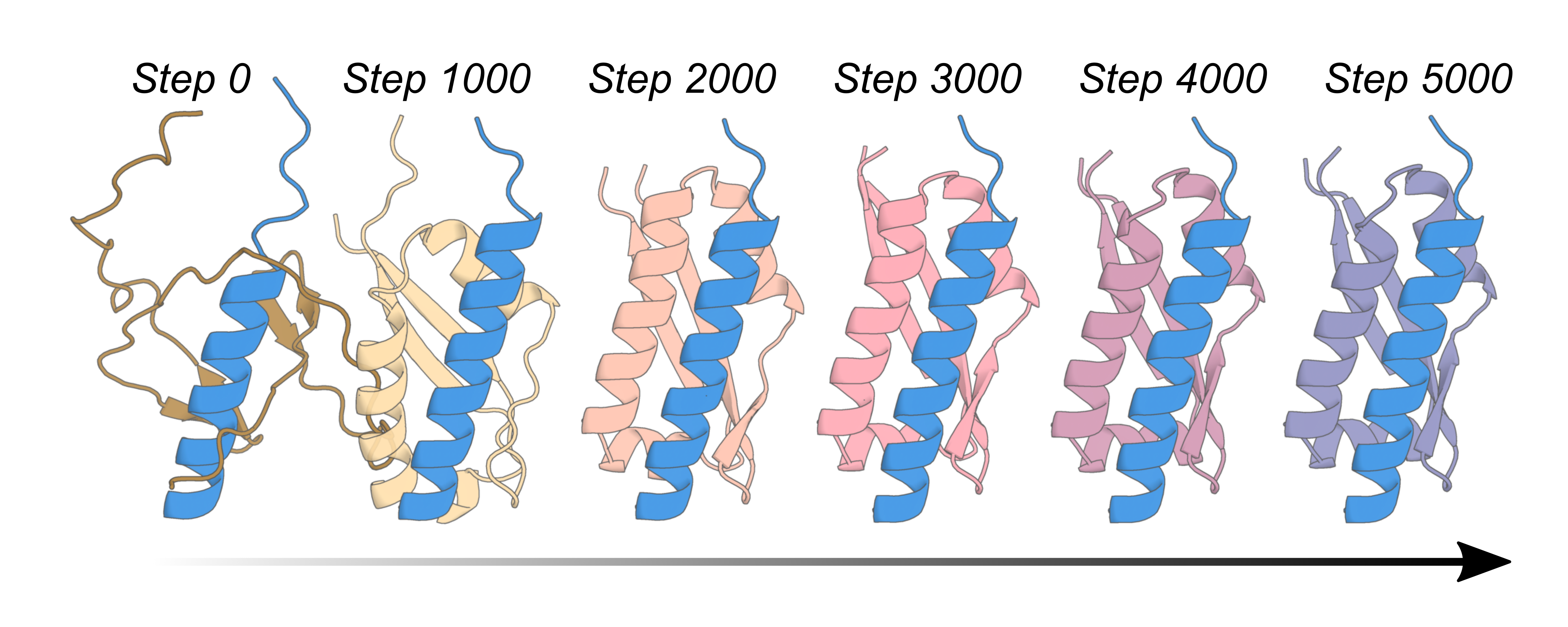Code for generating binders to flexible peptides using Hallucination (Activation Maximisation) with AlphaFold2.
The code is very heavily based upon, and uses much of the code from Basile Wicky and Lukas Milles' Oligomer Hallucination code, described in Wicky, B.I.M., Milles, L.F. Courbet, A. et al., Hallucinating symmetric protein assemblies, Science 2022.
The underlying method relies on the AlphaFold2 structure prediction network from Google Deepmind, described in Jumper, J. et al., Highly accurate protein structure prediction with AlphaFold, Nature 2021.
Author: Joseph L. Watson; joewatchwell.
As demonstrated in the Nature article, binders can be generated to flexible peptides using RFdiffusion, which produces higher quality outputs and is several orders of magnitude more compute-efficient. This code is provided for reproducibility purposes only.
RFdiffusion was originally described in Watson, J.L., Juergens, D., Bennett, N.R., Trippe, B.L., Yim, J., Eisenach, H.E., Ahern W. et al., De novo design of protein structure and function with RFdiffusion, Nature 2023.
- AlphaFold2 Hallucination for Flexible Peptide Binding
- Table of contents
- Getting started / installation
- Designing binders with AF2 Hallucination
- Downstream steps
- Acknowledgements
You'll first need to clone the repository and its submodules:
git clone --recursive https://github.com/RosettaCommons/AF2_peptide_hallucination.git
Ensure that you have either Anaconda or Miniconda installed.
You can then create a conda environment from the provided .yml file
conda env create -f env/SE3_PEPTIDE
conda activate SE3_PEPTIDE
By default, we clone the AlphaFold2 repository. If you already have AlphaFold2 installed locally, you can skip this step, but if not:
cd submodules/alpahafold
python setup.py install
Once you have installed everything, you're ready to go!
The goal of this project was to be able to design binders to flexible peptides (helical peptides in the Nature article).
The flexibility of the peptides means that there is no single static structure that the peptides adopt, and hence, we want to be able to design binders to a variety of the possible states.
We leveraged the fact that AF2 is a structure prediction network to simultaneously design binders while predicting the structure of the peptide sequence.
Therefore, the only required input is a peptide sequence and the length of the binder you want to Hallucinate.
The arguments are provided through Hydra configs. The default configuration can be found in config/base.yaml. You can either build a new config file, or specify arguments at the command line.
python run.py input.target_sequence=QEDIIRNIARHLAQVGDSMDRSIPPG input.binder_length=100
You probably want to change the output path:
output.out_dir=length_100_binders output.out_prefix=Bid_binders
By default, we won't override existing files, but this behaviour can be turned off:
output.cautious=False
For simplicity, the losses implemented in this repository are just those used to design binders in the Nature article, with very minor performance improvements. The default weights on each loss, as defined in the config file, are those used in the article. These can be modified trivially however. At the command line, you could, for example, provide:
loss.plddt=5 loss.ptm=0
This would upweight the plddt loss (from its default value of 1) and turn off the pTM loss.
These losses are defined in util/losses.py. It is very simple to add additional losses, if you so desire.
The hallucination parameters are taken directly from the Oligomer Hallucination repository. You can easily modify things like the Softmax temperature and half-life. For example:
hallucination.T_init=0.05 hallucination.half_life=500
Would start with a higher temperature (so higher chance of accepting a "bad" mutation) but a shorter half life (so this chance decays faster).
You can also try to optimise an existing binder. Here, we provide a specific starting sequence (rather than generating a random one).
input.binder_sequence=EELTIEVRIEGVDPETAARIEAIFKSVWEPRAKKLSLEGQKALVEALARALVAALKEHGIDARVHVKLIKDGEVVHELEF
Once you have run some Hallucination trajectories, you'll want to do some downstream processing before ordering. Following Wicky, B.I.M., Milles, L.F., Courbet, A. et al., Science 2022, who noted that the sequences that AF2 Hallucination produces are generally insoluble, in the Nature article we redesigned the sequence of the binders with ProteinMPNN, described in Dauparas, J. et al, Robust deep learning–based protein sequence design using ProteinMPNN, Science 2022.
We then filtered these sequences based on AF2 pLDDT, pTM, RMSD to the design model, RMSD of the monomer to the binder model (without the peptide), and Rosetta ddg.
This work was made possible by the following separate libraries and packages:
Thank you all their contributors and maintainers!
Questions and comments are welcome:
- Joseph Watson: jwatson3@uw.edu
